Overview – Attachment
An attachment is an emotional connection between an individual and another person (an attachment figure). When two people form an attachment bond, they feel more secure in each other’s presence and desire to be close to one another. Although there are many different types of attachment, A Level psychology primarily looks at attachments between infants and caregivers, including:
- Features of attachment
- The stages of attachment
- Explanations of attachment
- Types of attachment
- The influence of attachment on childhood and adult relationships
The syllabus also mentions various animal studies of attachment.
Caregiver-infant interactions
Features of caregiver-infant interactions
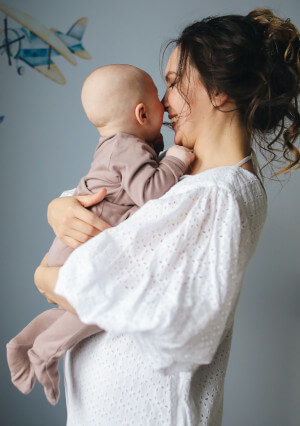 A newborn baby is unable to support itself, and so must develop attachment bonds with adults who can provide it with food, shelter, and protection.
A newborn baby is unable to support itself, and so must develop attachment bonds with adults who can provide it with food, shelter, and protection.
Although a newborn baby cannot speak with a caregiver to develop these bonds, there are several ways infants and caregivers communicate that help develop an attachment between them. The syllabus mentions two in particular: Interactional synchrony and reciprocity.
Reciprocity
Interactions between caregivers and infants are not simply one-way, they are reciprocal. For example, when the baby smiles, it will often make the mother smile back and vice versa. These kinds of reciprocal interactions strengthen the emotional connection between infant and caregiver.
Interactional synchrony
The reciprocal interactions between infant and caregiver are somewhat synchronised. For example, you might pull a funny face, the baby laughs, and then you laugh back. These kinds of interactions are rhythmic and co-ordinated, with both infant and caregiver ‘taking turns’ in a similar way to how adults take turns to speak in conversations. These synchronous interactions further strengthen the bond between infant and caregiver.
Other features:
- Mimicking
- Physical contact
- Motherese (i.e. slow, high-pitched, ‘baby talk’)
AO3 evaluation points: Features of caregiver-infant interactions
- Evidence supporting interactional synchrony: For example, Condon and Sander (1974) analysed video recordings of infants interacting with their caregivers and found the infants moved and reacted to the caregivers in a rhythm similar to adult speech. These observations support the concept of interactional synchrony. Further, interactional synchrony may play a role in the formation and strengthening of attachments: Isabella et al (1989) found interactional synchrony behaviours were correlated with secure attachment styles.
- Evidence supporting mimicking: Meltzoff and Moore (1977) found that infants copy the hand movements and facial expressions of caregivers, which supports mimicking as a feature of caregiver-infant interactions.
- Relative importance of different features: Some features of caregiver-infant interactions are more important for forming a bond than others. For example, there is little evidence to suggest motherese strengthens bonds between mothers and babies. However, physical contact appears to be important. For example, Klaus and Kennell (1977) found that mothers who had extensive physical contact with their babies in the first few days of life had closer bonds than those who only had physical contact with their babies during feeding.
Rudolph Schaffer: Stages of attachment
Infant development typically progresses according the following cycle, as identified by Schaffer and Emerson (1964) and described in Schaffer (1996):
| Pre-attachment (Birth – 3 months) |
From a very early stage, babies enjoy the company of other people and prefer humans over objects and other non-human things. However, the baby is not able to tell the difference between different human faces. |
| Indiscriminate attachment (3 months – ~8 months) |
After about 3 months, the baby can tell the difference between different human faces and starts to prefer familiar ones. However, the baby does not mind unfamiliar faces and will allow a stranger to handle them without getting upset. |
| Specific attachment (~8 months onwards) |
From about 7 or 8 months, the baby’s attachment to its primary caregiver (e.g. its mother) is particularly strong. The baby demonstrates separation anxiety (distress from being away from its primary caregiver) and a fear of strangers. |
| Multiple attachments (~10 months onwards) |
After around 9 or 10 months, the infant will begin forming attachments to other familiar faces, such as grandparents and other children. However, the strongest emotional attachment is with the primary caregiver (usually the mother). |
The role of the father
In most cases, an infant’s primary attachment figure will be its mother. However, in many cases, it will be the father instead.
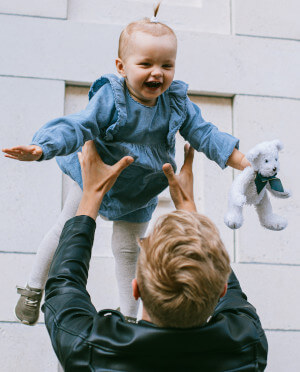 Traditionally, mothers and fathers play different roles. The mother is typically seen as occupying the caregiving and nurturing role to the infant, whereas the father is seen as a playmate who provides more physical and exciting play than the mother. Due to this, infants tend to prefer contact with their fathers when they are feeling happy and positive and want to play, but prefer contact with their mothers when they are upset and want comforting.
Traditionally, mothers and fathers play different roles. The mother is typically seen as occupying the caregiving and nurturing role to the infant, whereas the father is seen as a playmate who provides more physical and exciting play than the mother. Due to this, infants tend to prefer contact with their fathers when they are feeling happy and positive and want to play, but prefer contact with their mothers when they are upset and want comforting.
Although fathers have typically been seen as occupying a less important role than the mother, societal changes (such as more mothers going out to work) mean men are often expected to play a bigger role in parenting than before. It is increasingly common for men to be the infant’s primary caregiver instead of just a playmate.
Animal studies of attachment
A lot of early psychological research into attachment was conducted on animals. This is because such research is generally considered more ethical than if conducted on humans, yet there are many similarities between humans and animals that can inform knowledge of human psychology.
Konrad Lorenz: Imprinting
 Imprinting is a form of attachment where an animal (particularly birds) develops an attachment to the first large moving object it sees. In 1935, Konrad Lorenz conducted a study with the aim of investigating the mechanisms and effects of imprinting.
Imprinting is a form of attachment where an animal (particularly birds) develops an attachment to the first large moving object it sees. In 1935, Konrad Lorenz conducted a study with the aim of investigating the mechanisms and effects of imprinting.
The procedure of Lorenz’s experiment was as follows:
- Lorenz split a clutch of goose eggs into two groups:
- One group of goslings hatched naturally by the mother.
- The other group hatched in an incubator, and Lorenz himself was the first moving object the newly hatched goslings experienced.
- Lorenz marked the goslings so he could tell which ones were in which group.
- Then, the goslings were placed together under a box.
- When the box was lifted up, their behaviour was recorded.
The results were as follows:
- The naturally hatched goslings followed their mother immediately after birth, whereas the incubator goslings followed Lorenz about.
- In the box test, the naturally hatched goslings went straight to their mother once the box was lifted up, whereas the incubator goslings went straight to Lorenz.
This experiment demonstrates imprinting. The newly hatched goslings developed an attachment to the first moving object they encountered, regardless of whether it was their biological mother or not. Lorenz noted that imprinting occurred within 4-25 hours after birth.
AO3 evaluation points: Lorenz's imprinting studies
- Relation to other theories: The fact that the imprinting always occurred within 4-25 hours after birth could provide support for Bowlby’s concept of a critical period for newborn baby humans to form attachments.
- Methodological concerns: Geese are very different to humans and so is unclear from this study the extent to which imprinting occurs in newborn baby humans (if at all).
Harry Harlow: Food vs. comfort
The aim of Harry Harlow’s 1959 studies was to test whether attachment is based solely on food (as learning theory might suggest) or whether there is more to attachment than this.
The procedure was as follows: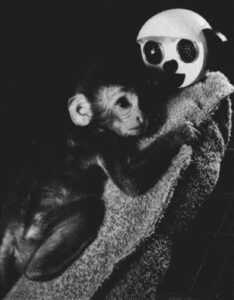
- 16 baby monkeys were separated from their natural mothers.
- In place of the natural mother, the monkeys were put into cages and given surrogate mothers in 1 of 4 possible setups:
- A wire mother who produced milk and a soft towel mother who did not produce milk.
- A wire mother who did not produce milk and a soft towel mother who did produce milk.
- Only a wire mother who produced milk.
- Only a soft towel mother who produced milk.
- Harlow recorded how much time the monkeys spent with each mother and how much time they spent feeding.
- Harlow would occasionally expose the monkeys to a loud noise to test which mother they preferred under stress.
The results were as follows:
- Monkeys spent more time with the soft towel mother regardless of whether it produced milk or not.
- When exposed to the loud noise, monkeys would cling on to the soft towel mother for comfort.
- Monkeys with only the wire mother exhibited physiological signs of stress such as diarrhoea.
These experiments suggest monkeys are born with an innate need for comforting via physical contact and that this physical contact is more important for attachment than food is (as learning theory might suggest). A lack of physical contact is likely to cause stress in infant monkeys.
AO3 evaluation points: Harlow's food vs. comfort studies
- Ethical concerns: Harlow’s experiments have been criticised as unethical due to the harm inflicted on the monkeys.
- Methodological concerns: As an animal study, it is unclear whether the results can be generalised to human beings.
Explanations of attachment
The syllabus mentions two explanations of why humans form attachments: Learning theory (behaviour learned through conditioning) and Bowlby’s monotropic theory (the result of an innate instinct to form an attachment).
Learning theory
Learning theory explains attachment as behaviours learned through conditioning.
Classical conditioning (see the approaches page for more details) occurs when a naturally pleasurable stimulus (in this case, feeding) becomes associated with a neutral stimulus (in this case, the caregiver). Because the pleasurable stimulus (feeding) occurs at the same time as the neutral stimulus (the caregiver’s presence), the infant eventually learns to associate the caregiver with pleasure even without food:
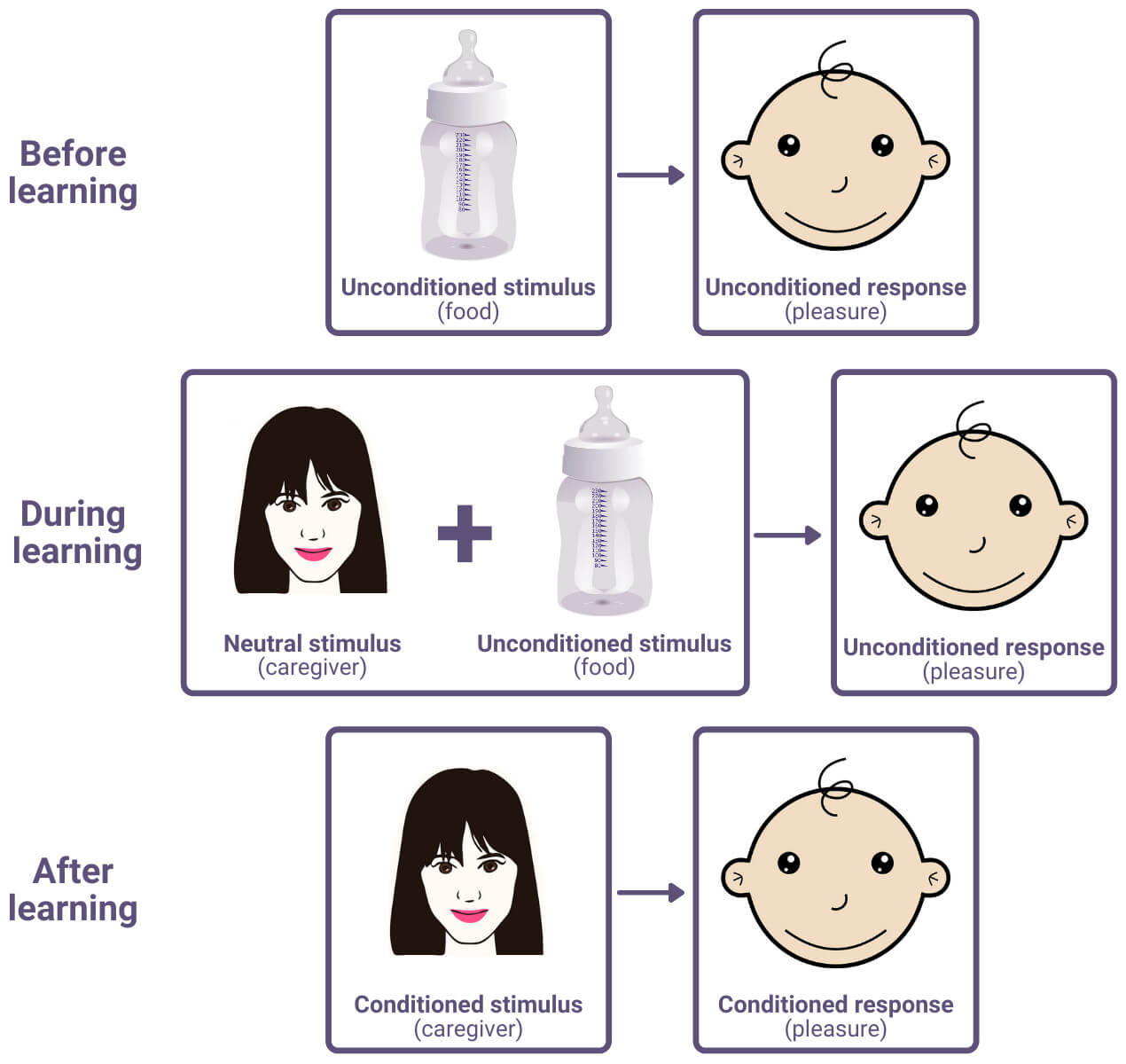
Learning theories of attachment may also reference operant conditioning (again, see the approaches page for more details). For example, reducing the unpleasant feeling of hunger may negatively reinforce attachment towards the caregiver.
AO3 evaluation points: Learning theory of attachment
Strengths of learning theory of attachment:
- Theoretical support: The learning theory of attachment is based on behaviourism, which has some supporting evidence. For example, Pavlov demonstrated classical conditioning in dogs, which may apply to humans and attachment behaviours.
Weaknesses of learning theory of attachment:
- Conflicting evidence: Schaffer and Emerson (1964) found that 39% of infants developed a primary attachment to someone other than the mother (the person who fed them). Further, Fox (1977) studied attachments in Israeli kibbutzim, where babies would often be fed by caregivers called metapelets. Despite being fed by the metapelets, most babies were more attached to their mothers. These examples suggest factors other than food are needed to explain attachment. Harlow’s research on monkeys also challenges the learning theory of attachment because the monkeys were more attached to the comforting mother than the feeding mother, which may translate to human attachment too.
- Reductionist: Although conditioning may explain some behaviours, to explain all attachment behaviour in terms of conditioning may be overly reductive. For example, the learning theory of attachment ignores all the cognitive processes and emotions that influence attachment.
John Bowlby: Monotropic Theory
Bowlby rejects learning theory as an explanation of attachment. Influenced by Lorenz and Harlow’s animal studies, Bowlby instead argued that humans evolved an innate capacity to form an attachment to one (hence monotropic) attachment figure from birth – usually the mother. Although infants may develop other attachments beyond this, these attachments are secondary and much less important.
Bowlby’s explanation of monotropic theory is evolutionary: In a dangerous environment, infants would die if left to fend for themselves, so nature selects for those babies who naturally behave in ways that form bonds with caregivers who will protect them. These natural behaviours are not learned, as learning theory suggests, but are instead pre-programmed from birth (innate).
Critical period
According to Bowlby’s theory, there is a critical period within which an infant can develop attachments. After this period, the infant will have difficulty forming attachments at all.
For most infants, this critical period is 12 months after birth. Although some infants may develop attachments after this time, Bowlby believed all infants must develop attachments within 3 years. According to Bowlby’s maternal deprivation hypothesis, forming an attachment to the mother in this critical period is essential for healthy psychological development.
Internal working model
Bowlby’s theory says that an infant’s monotropic (primary) attachment forms a template for all relationships that follow. This template is known as the internal working model and is a cognitive framework through which the individual understands themself and their expectations for relationships to other people. The internal working model also creates some consistency between the emotional experiences of early life and the emotional experiences of later relationships.
AO3 evaluation points: Monotropic theory of attachment
Strengths of monotropic theory of attachment:
- Supporting evidence: Fox (1977) studied attachments in Israeli kibbutzim, where babies would often be cared for by caregivers called metapelets while the biological mother went out to work. Despite spending much less time with the mother than the metapelet, many babies formed monotropic bonds with their mothers. Further, Lorenz’s observation that imprinting in newborn goslings could only occur 4-25 hours after birth provides support for a critical period in human infant development. This imprinting behaviour is also monotropic: the goslings became attached to a single person (or large moving object) only. However, as an animal study, it is unclear how much Lorenz’s findings translate to humans.
Weaknesses of monotropic theory of attachment:
- Conflicting evidence: In contrast to Bowlby, Schaffer’s stages of attachment show that most babies develop multiple attachments after 10 months, rather than just the one monotropic attachment proposed by Bowlby. Further, Rutter’s Romanian orphan studies suggest that infants can form attachments even after the critical period proposed by monotropic theory.
- Stereotypical: Bowlby’s monotropic theory supports the sex-role stereotype that women should stay home looking after children. However, some research suggests that fathers can fulfil this role instead.
Types of attachment
The syllabus lists 3 types of infant attachment styles: secure, insecure-avoidant, and insecure-resistant. These differing attachment styles can be observed in the strange situation procedure, which produces varying outcomes when conducted in different cultures.
Mary Ainsworth: Strange situation
Ainsworth et al (1978) developed a method for testing infant attachment known as the strange situation.
The procedure for the strange situation involves exposing infants to 8 ‘episodes’ (each around 3 minutes in duration) during which various people enter and leave a room. The sequence of these 8 episodes is as follows:
| Mother + infant + observer | Observer takes mother and infant into the room and leaves. |
| Mother + infant | Mother allows the infant to explore the room with her present. |
| Mother + stranger + infant | A stranger enters the room. For the first minute, the stranger is silent. Then, the stranger talks to the mother. Then, the stranger approaches the infant. Then, the mother leaves the room. |
| Stranger + infant | The stranger interacts with the infant (this is the first separation episode). |
| Mother + infant | The stranger leaves, the mother returns and plays with the infant for a while (this is the first reunion episode) and then leaves again. |
| Infant | The infant is left alone in the room (this is the second separation episode). |
| Stranger + infant | The stranger returns to the room and interacts with the infant (a continuation of the second separation episode). |
| Mother + infant | The mother returns and comforts the infant (this is the second reunion episode), the stranger leaves. |
One of Ainsworth’s strange situation studies involved 106 infants 9-18 months old and their mothers. The aim of this study was to test the infants’ stranger anxiety, separation anxiety, and reunion behaviour. Ainsworth also wanted to observe infants’ exploration behaviour (which is seen as important for cognitive development).
AO3 evaluation points: Strange situation procedure
- Replicable and reliable: Ainsworth’s procedure has a clearly defined procedure with operationalised variables. This enables researchers to replicate the study and verify the reliability of the findings.
- Questions of ecological/external validity: The strange situation procedure is conducted in a laboratory and follows a script that may be unlike real life separations. For example, Brofenbenner (1979) found infants were more distressed when separated from parents in the laboratory situation than at home due to the unfamiliar environment. As such, findings from these studies may lack ecological validity when applied to real-life attachments.
- Ethical concerns: Some may argue that the strange situation procedure is unethical as it involves deliberately causing stress to infants. On the other hand, this stress caused is similar to everyday experiences for infants (e.g. being left at pre-school or with a babysitter).
Types of attachment
Ainsworth identified 3 types of attachment from observation of the infants’ behaviour during the strange situation procedure: secure attachment, insecure-avoidant, and insecure-resistant.
Secure
Around 70% of infants exhibited behaviours associated with secure attachment:
- Stranger anxiety: The infant is happy and plays as normal when both the mother and stranger are present, but becomes distressed when the mother leaves them alone with the stranger.
- Separation anxiety: The infant becomes distressed when the mother leaves.
- Reunion behaviour: The infant is calmed and becomes happy again once reunited with the mother.
- Exploration behaviour: The infant uses the mothers as a ‘base’ from which to safely explore the room and return to.
Insecure-avoidant
Around 15% of infants exhibited behaviours associated with insecure-avoidant attachment:
- Stranger anxiety: The infant does not become distressed when left alone with the stranger and carries on playing as normal.
- Separation anxiety: The infant does not become distressed when the mother leaves.
- Reunion behaviour: The infant carries on playing and is indifferent when the mother returns.
- Exploration behaviour: The infant explores its environment, but does not treat the mother as the base from which it explores and returns to.
Insecure-resistant
Around 15% of infants exhibited behaviours associated with insecure-resistant attachment:
- Stranger anxiety: The infant avoids the stranger even when the mother is also present.
- Separation anxiety: The infant becomes distressed when the mother leaves.
- Reunion behaviour: The infant seeks the mother when she returns, but resists direct contact (e.g. pushing her away)
- Exploration behaviour: The infant is much less likely to explore its environment.
Van Ijzendoorn: Cultural variations in attachment
Many studies across many different cultures have used the strange situation procedure to measure attachment styles. Van Ijzendoorn and Kroonenberg (1988) conducted a meta-analysis (a study of studies) with the aim of determining whether attachment styles are universal across cultures or whether cultural conditions affect attachment styles.
The procedure for the meta-analysis involved collecting data from 32 studies across 8 countries. Together, these studies observed a total of 1990 mother-child pairs in the strange situation procedure.
The results of the meta-analysis were as follows:
| Country | Number of studies | Secure | Insecure-avoidant | Insecure-resistant |
| USA | 18 | 65% | 21% | 14% |
| Netherlands | 4 | 67% | 26% | 7% |
| Germany | 3 | 57% | 35% | 8% |
| Japan | 2 | 68% | 5% | 27% |
| Israel | 2 | 64% | 7% | 29% |
| Britain | 1 | 75% | 22% | 3% |
| Sweden | 1 | 75% | 22% | 4% |
| China | 1 | 50% | 25% | 25% |
These results suggest that culture does play a part in attachment styles. For example, studies in Western cultures (e.g. Germany, Britain, USA) tended to observe significantly higher insecure-avoidant attachment styles. In contrast, Japan, China, and Israel had significantly higher insecure-resistant attachment styles.
However, in many cases, intra-cultural differences (differences between studies conducted within the same country) were often greater than inter-cultural differences (differences between studies conducted in two different countries). For example, while one USA study observed 94% of infants had insecure-avoidant attachments, a different USA study observed that just 47% of infants had insecure-avoidant attachments.
Effects of attachment
Attachments in infancy appear to be highly important for psychological development. The syllabus looks at the influence of infant attachment on adult psychology, as well as the effects of breaking early attachments as observed in the Romanian orphan studies and according to Bowlby’s maternal deprivation hypothesis.
John Bowlby: Maternal deprivation hypothesis
Bowlby argued that attachments between infants and their mothers – particularly during the critical period before age 3 – are essential to healthy psychological development.
According to Bowlby, infants separated from their mothers for a short time (e.g. being left with a babysitter) display the following pattern of behaviour:
- Protest: Outward expressions of separation anxiety (e.g. crying, kicking, and running away)
- Despair: The infant still feels separation anxiety inwardly, but the behaviour becomes more apathetic (e.g. sulking, sucking thumb for comfort, etc.)
- Detachment: The infant will interact with people again, but may initially reject the mother when she returns due to anger
More importantly, Bowlby argued that if infants are separated from their mothers for a long time (deprivation) during the critical period (e.g. when the mother dies) then it will permanently damage the infant’s psychological development. For example, he believed that maternal deprivation can lead to aggression, social maladjustment, and depression.
Bowlby’s maternal deprivation hypothesis is supported by observations from his clinical work with children. In Bowlby (1944), Bowlby interviewed 44 children who had been referred to him for stealing and compared them to a control group of 44 ’emotionally disturbed’ children who did not steal:
- Of the 44 thieves, 17 (39%) had been separated from their mothers before age 2
- In comparison, just 2 children in the control group (4.6%) had been separated from their mothers before age 2
- Further, Bowlby identified 14 of the thieves as ‘affectionless psychopaths’, and of these 14 affectionless psychopaths, 12 (86%) had been separated from their mothers for more than 6 months before age 2.
AO3 evaluation points: Bowlby's maternal deprivation hypothesis
Strengths of maternal deprivation hypothesis:
- Supporting evidence: In addition to Bowlby’s observations above, Goldfarb (1943) also supports the maternal deprivation hypothesis. Goldfarb found that children raised in orphanages (i.e. without mothers) for the first 3 years of life suffered intellectually and socially in later life.
Weaknesses of maternal deprivation hypothesis:
- Methodological concerns: Bowlby’s study took the form of interviews with the subjects. However, this method has been criticised for researcher bias as Bowlby’s own theories and pre-conceived ideas may have influenced the questions he asked and his interpretations of the answers. For example, Bowlby’s expectation that maternal deprivation could cause a child to become an ‘affectionless psychopath’ could have biased him to diagnose children who were separated from their mothers as such. Because of this, Bowlby’s maternal deprivation hypothesis may not be valid.
- Reversible: Bowlby’s maternal deprivation hypothesis argued that the effects of deprivation in the critical period permanently damage the infant’s psychological development. However, Rutter’s Romanian orphan study suggests these effects are largely reversible, which weakens support for Bowlby’s hypothesis.
- Alternative explanations: Although Bowlby and Goldfarb (1943) demonstrate correlations between maternal deprivation and poor psychological development in later life, this does not prove maternal deprivation causes poor psychological development. For example, it could be that poor conditions in the orphanages (e.g. poverty, crowding, etc.) are what caused poor psychological development in these children rather than maternal deprivation specifically.
Institutionalisation
Privation is when an infant never forms an attachment. It may occur when an infant is raised away from their parents in an institution such as an orphanage or a children’s home. The psychological and behavioural effects of being raised in such institutions are known as institutionalisation.
Effects of institutionalisation may include:
- Delayed language development
- Mental retardation/low IQ
- Disinhibited attachment (e.g. treating strangers the same way they would their primary caregiver)
- Delayed physical development (e.g. reduced growth)
- Difficulties forming relationships in adulthood
Romanian orphan studies
Rutter et al (1998) studied the effects of privation and institutionalisation in their Romanian orphan studies. Conditions in Romania in the early 1990s were difficult, and the children placed in orphanages suffered from minimal contact with adults and poor nutrition. A key aim of Rutter’s study was to see whether the effects of such extreme privation in early life could be overcome with love and care.
The procedure of the studies was as follows:
- The subjects were 111 children who had been placed in Romanian orphanages before 2 weeks of age. Rutter and colleagues studied these children according to 3 categories:
- Children adopted into British families before 6 months old
- Children adopted into British families between 6 months and 2 years of age
- Children adopted into British families after 2 years of age
- The control group was 52 British children adopted into British families
- The study was a longitudinal study: it would measure the physical and cognitive development of infants at ages 4, 6, and 11
The findings from the follow ups were as follows:
- By age 4, the Romanian orphans adopted before 6 months old had caught up (physically and cognitively) with the British orphan control group
- By age 4, the Romanian orphans adopted after 6 months old had made significant physical and cognitive progress but had not fully caught up with the British orphan control group. Many of the orphans in this group displayed disinhibited attachments
- A subsequent follow up at age 6 found the developmental improvements were maintained but not improved upon
- And at age 11, around 50% of the children who had displayed disinhibited attachments early on were still doing so
These findings suggest institutionalisation can be largely reversed if the infant is shown love and care. However, the longer the infant goes without forming an attachment, the more likely they are to suffer permanent developmental issues.
AO3 evaluation points: Romanian orphan studies
- Rutter did not have much information on the infants’ lives in orphanages prior to adoption and so relevant experiences in these institutions could have been missed. This lack of information makes it difficult to determine the extent of each orphan’s privation and identify which aspects are most important for development.
- Bowlby’s maternal deprivation hypothesis argued that the effects of deprivation in the critical period permanently damage the infant’s psychological development, but Rutter’s findings suggest these effects are largely reversible.
The influence of early attachment
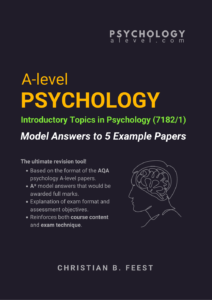 Bowlby’s internal working model forms the basis of the continuity hypothesis: the theory that attachments in early life form the basis for attachments later on, i.e. that there is continuity between early and later attachments.
Bowlby’s internal working model forms the basis of the continuity hypothesis: the theory that attachments in early life form the basis for attachments later on, i.e. that there is continuity between early and later attachments.
Example question: Discuss the influence of early attachment on relationships as an adult. [8 marks]
In childhood
Research suggests early infant attachments affect friendships in childhood.
For example, Youngblade and Belsky (1992) conducted a longitudinal study of 73 children. They found that children who had demonstrated secure attachment styles at 1 year old (as measured using the strange situation procedure) were more likely to have close friendships and get along well with other children by ages 3-5. The continuity between infant attachment and child friendships is also supported by Laible et al (2000), who found that adolescents who scored highly for parent attachment were also more likely to score highly for peer attachment too.
In adulthood
The continuity with infant attachments extends into adulthood too. Both romantic attachments and parenting styles are correlated with infant attachment styles.
Romantic relationships
Hazan and Shaver (1987) conducted a study to test for continuity between infant attachment styles and romantic attachments as adults. Participants completed questionnaires that asked them to say which of 3 statements best applied to their feelings on romantic relationships – and each of these 3 statements would correspond to one of Ainsworth’s attachment styles (secure, insecure-avoidant, and insecure-resistant). Participants were also asked to complete a checklist on childhood relationships with parents, with answers again corresponding to Ainsworth’s attachment styles.
The researchers found correlations between infant attachment styles and views on romantic relationships. For example, participants who were identified as securely attached infants from the childhood checklist tended to have longer lasting relationships and lower divorce rates as adults compared to those with insecure infant attachment styles. Both insecure attachment styles were more vulnerable to loneliness, with insecure-resistant types being most likely to be lonely. Adults who had insecure-avoidant attachment styles as infants tended to believe that love is rare and felt that they did not need romantic partners to be happy.
Parenting style
Several studies, for example Bailey et al (2007), have found that attachment styles in infancy are correlated with parenting styles in adulthood.
AO3 evaluation points: Continuity hypothesis
Strengths of continuity hypothesis:
- Supporting evidence: See studies above.
Weaknesses of continuity hypothesis:
- Alternative explanations: The continuity between infant attachment and relationships in adulthood could be explained in other ways besides the continuity hypothesis. For example, Kagan and Snidman (2004) instead argue for the temperament hypothesis: The idea that humans have innate and biologically determined personality traits. These innate character traits are present from birth and are consistent into adulthood, and it is these innate character traits that influence both infant and adult relationship styles rather than a learned internal working model as proposed by Bowlby.